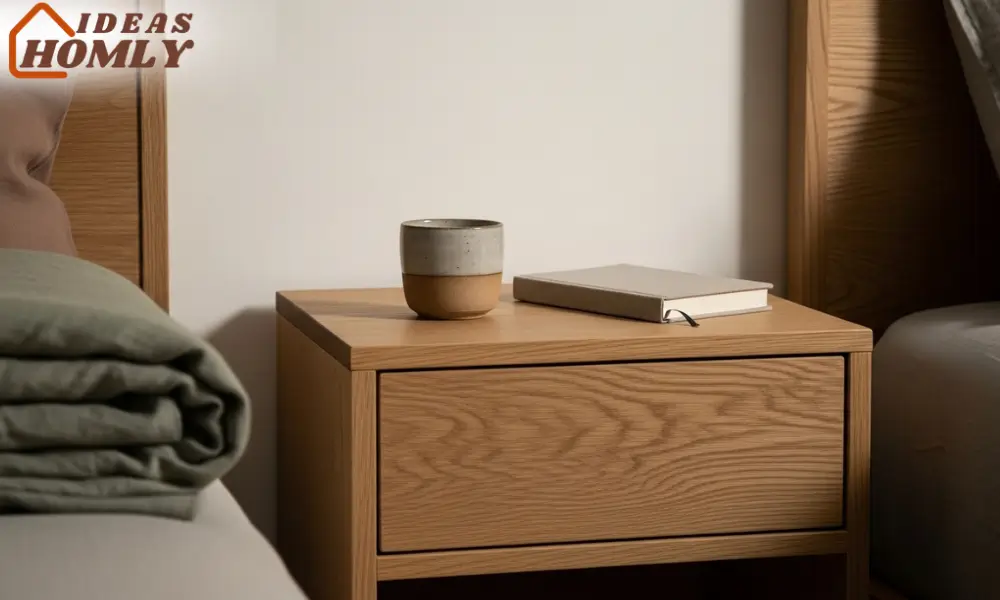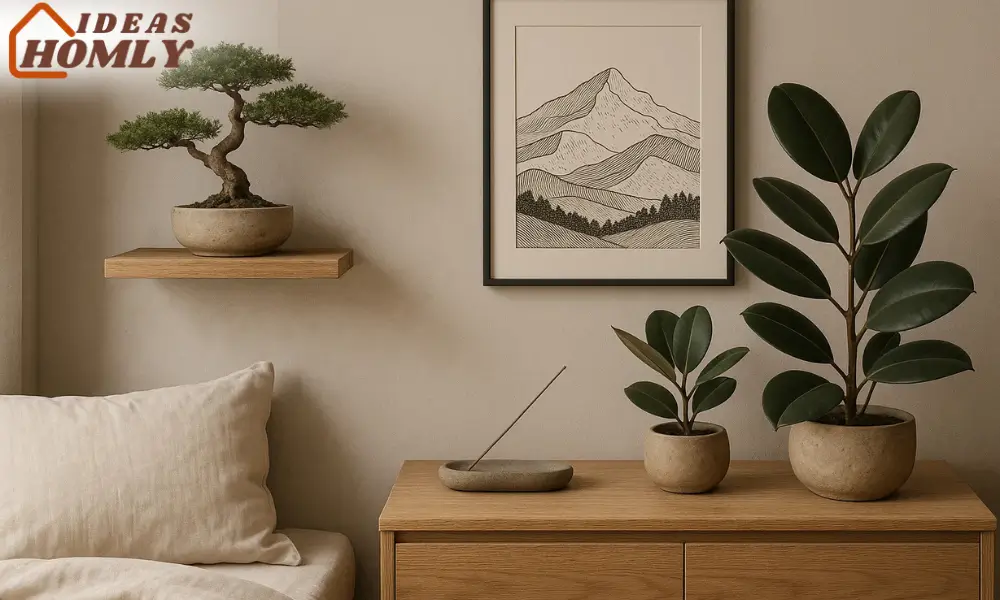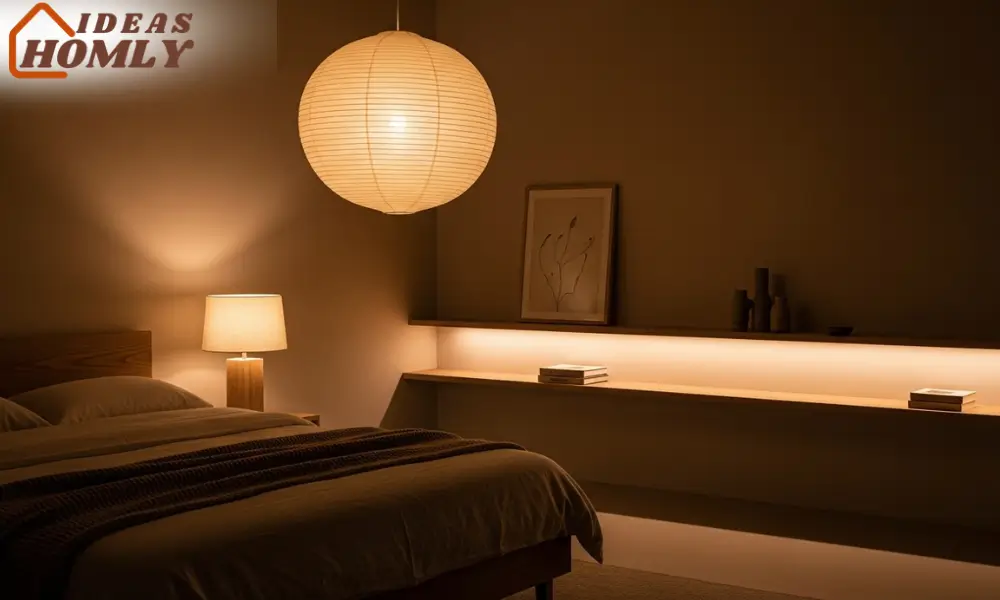I’ll be honest, I’m a little obsessed with Japandi. There’s just something about the way it blends Japanese simplicity with Scandinavian warmth that speaks to my soul.
If you’re anything like me, and your idea of a dream bedroom includes soft textures, clean lines, and calming vibes (minus the chaos), then Japandi is your 2025 must-have bedroom trend.
This style has skyrocketed in popularity and for good reason. Japandi takes the best of minimalism and coziness and fuses them into one peaceful, clutter-free space. It’s no wonder why more people are ditching loud, cluttered decor in favor of this timeless aesthetic.
Here, I’ll discuss 5 Japandi style bedroom design ideas that I absolutely love (and personally use). These ideas are perfect for creating a bedroom that helps you unwind, sleep better, and wake up happier. No fluff just calm, clean, and seriously beautiful design.
1. Neutral Tones + Natural Wood Harmony
The first rule of Japandi club? Stick to a calm color palette. And I don’t mean beige-everything boring, I’m talking about rich, earthy neutrals mixed with warm, organic materials.
I start by choosing soft tones like warm white, taupe, sand, clay, and charcoal grey. These shades create a clean canvas and help reflect natural light. They also make the room feel larger, which I love for smaller bedrooms.
Then comes the wood. And oh, do I love Japandi wood tones like natural oak, ash, beech, and walnut are the stars here. I always go for furniture with a matte finish or raw texture. It feels grounded and timeless, without looking too rustic or too polished.
What makes the magic happen is the balance. The contrast of dark accents against soft wood grains gives depth to the room without visual chaos. Think light oak bed frames paired with a charcoal linen throw. Or pale wooden nightstands next to off-white walls.
Avoid overly yellow or orange wood tones. They clash with Japandi’s calm color story.

| Japandi Color Palette | Common Materials |
|---|---|
| Warm white | Natural oak |
| Soft taupe | Bamboo |
| Slate grey | Linen |
| Earthy clay | Organic cotton |
| Muted sage | Woven hemp |
2. Low Profile Furniture: The Japandi Bed
Let’s talk about the heart of any bedroom the bed. In Japandi design, low-profile furniture is key, and I swear by it.
A low-slung bed frame not only looks sleek, but it also helps ground the space. It reminds me of traditional Japanese futon-style beds, but with a Scandi twist. I personally love how it makes the ceiling feel higher and the room more open. It’s like an instant mental detox.
For my Japandi bedroom, I chose a simple wooden bed frame with visible grain, minimal hardware, and no headboard clutter. It’s so clean and intentional. No heavy, overstuffed designs. No pointless details. Just simplicity that breathes.
Most Japandi furniture follows this principle: function first, beauty always. Every item should serve a purpose. And if it doesn’t? Out it goes. That’s my golden rule.
You’ll notice most Japandi beds don’t have under-bed storage drawers. Why? Because clutter-free living is part of the philosophy. If I need extra storage, I opt for hidden baskets or keep it vertical using sleek wall-mounted shelves.
The first night I slept in my Japandi bedroom, I didn’t want to leave. It felt like a mini retreat after a long day of chaos.
Quick Tips for the Perfect Japandi Bed Setup:
- Choose platform beds with clean lines.
- Use mattresses without box springs.
- Skip flashy headboards, try a simple wooden or fabric backrest.
- Keep bedding neutral and go for layered linen textures.

3. Layered Natural Textures: Linen, Hemp, Bamboo
This part is honestly my favorite. I’m a sucker for cozy textures, and Japandi gives me full permission to layer them without overdoing it.
Instead of bold prints or heavy fabrics, I go for organic materials that add depth in the most subtle way. Think stonewashed linen bedding, a hemp area rug, and woven bamboo blinds. The combo is soft on the eyes and on the soul.
One thing I’ve learned? Layering doesn’t mean piling things on. It means mixing light, breathable textures that complement each other. For example, I’ll pair crisp linen pillowcases with a soft cotton quilt. Then I’ll throw in a textured wool cushion or two for contrast.
And the feeling when you get into a bed made up of natural, breathable fabrics? Absolute heaven. Plus, materials like linen and hemp are moisture-wicking, sustainable, and get softer with every wash. So yes, it’s functional and luxurious.
Avoid shiny synthetics. They clash with the calm, matte feel of Japandi style. Stick to earthy finishes like rough, raw, and real.

Here’s a simple layering formula I follow:
| Element | Material Suggestion |
|---|---|
| Bed sheets | 100% linen or organic cotton |
| Throws | Soft wool, raw silk, or bamboo |
| Rugs | Jute, hemp, or sisal |
| Curtains | Gauzy cotton or linen blends |
| Decor pillows | Boucle, stonewashed linen |
4. Subtle Nature Motifs and Plants
Japandi bedrooms love nature, but not in a chaotic jungle-way. It’s more about subtle references like a single bonsai on a shelf, or a framed line drawing of a branch.
I always say: bring the outdoors in, but keep it calm. I like to use a few indoor plants with sculptural leaves nothing too frilly. My go-to Japandi plants include snake plants, rubber plants, and my absolute favorite: ZZ plants. They’re low-maintenance and add instant serenity.
For nature motifs, I personally like wall prints or ceramics that use simple, black linework to sketch leaves or mountains. Nothing loud. Nothing neon. Just that quiet nod to nature’s beauty.
I also add a couple of raw stone or ceramic decor pieces, they look handmade, imperfect, and natural. It gives that beautiful Wabi-sabi vibe without being overly rustic.
Fun fact: Japandi interiors often reflect seasonal rhythms. So I sometimes swap in dried branches during winter and leafy greens in spring. It’s small, but it makes a difference.
My favorite Japandi-friendly decor picks:
- Unglazed clay vases
- Framed line art of leaves or landscapes
- Sculptural dried twigs in a minimalist pot
- Tabletop pebbles or stones
- Simple ceramic incense holders

5. Soft Lighting to Maximize Serenity
Lighting makes or breaks the Japandi mood. Harsh ceiling lights? Absolutely not. I learned the hard way that cool-toned LEDs can ruin everything, it’s like trying to meditate under a dentist’s lamp.
So I swapped all my bulbs for warm white (2700K) and focused on layered, diffused lighting. Think soft table lamps, paper lanterns, and floor lamps with rice paper shades.
I especially love pendant lights made from woven bamboo or natural fabric. They feel warm, they spread a soft glow, and they’re functional too. And honestly, they look like floating sculptures.
I usually have 2-3 light sources in my Japandi bedroom:
- A low table lamp with a linen shade
- A floor lamp next to my reading chair
- Sometimes a paper lantern pendant above the bed
What I avoid like the plague? Spotlights, crystal chandeliers, or anything overly reflective.
Try this: Instead of a bright ceiling light, add LED strip lights under floating shelves for that ambient glow. It’s minimal, modern, and soothing.
| Lighting Type | Best Material | Effect on Mood |
|---|---|---|
| Paper lanterns | Rice paper | Soft, dreamy glow |
| Table lamps | Linen or ceramic base | Cozy and grounded |
| Bamboo pendant lights | Woven bamboo or rattan | Warm and textured feel |
| LED strip lights | Hidden under furniture | Subtle ambient touch |

Common Japandi Mistakes to Avoid
Now, let me be real for a moment. When I first tried Japandi styling, I made some cringe-worthy mistakes. You don’t have to suffer the same fate, so here are a few missteps I often see (and sometimes made myself):
1. Mixing Too Many Styles
Japandi is all about balance. Adding in too many boho throws, farmhouse signs, or glam mirrors can completely throw off the clean, serene vibe. I learned the hard way that less is truly more.
2. Overcrowding the Room
Even if the items are Japandi-inspired, packing the space kills the calm. I now ask myself: “Does this object have a purpose?” If not, it’s out. Keep only what brings value, peace, or joy.
3. Wrong Color Temperatures
I once installed bright blue-toned bulbs thinking they were “modern.” Huge mistake. Japandi needs warm, soft lighting. Always check the bulb’s color temp, 2700K to 3000K is perfect.
4. Choosing Fake-Looking Materials
Shiny plastic pretending to be wood? That’s a Japandi disaster. Stick to real or convincingly natural materials like raw wood, stone, rattan, linen, or matte ceramics.
5. Going Too Cold or Too Zen
Japandi is not cold minimalism. It still needs a touch of warmth; a cozy throw, a small plant, or a personal item can make all the difference.
Where to Shop Japandi Furniture & Decor
If you’re wondering where I get my Japandi pieces without selling a kidney, here’s my go-to list of budget-friendly + stylish options:
| Store Name | Why I Love It |
|---|---|
| IKEA | Affordable, clean lines, lots of wood options |
| H&M Home | Subtle linen textiles and ceramic accessories |
| MUJI | Minimal, Japanese-inspired basics |
| Urban Outfitters | Woven lighting and earthy accents |
| Amazon | Great for essentials like neutral rugs or lamps |
| Etsy | Handmade, natural, and very Japandi-friendly |
| Zara Home | Elegant, muted-toned textiles and décor |
I also keep an eye on local thrift stores for unique, imperfect ceramics or second-hand wooden stools. They add so much character.
Conclusion
Creating a Japandi bedroom isn’t about following a strict formula, it’s about building a space that breathes calm and intention.
By focusing on neutral colors, natural materials, low-profile furniture, cozy layers, and nature-inspired accents, I’ve turned my bedroom into a peaceful retreat that genuinely helps me unwind.
It’s minimal, yes. But it’s never boring. And in 2025, with the world feeling louder than ever, that’s exactly what we need.
So whether you’re revamping your whole bedroom or just starting with a Japandi-style lamp and some linen sheets, trust me, it’s worth it. Your mind (and sleep) will thank you.
FAQs
Not exactly. While Japandi shares minimalist principles, it’s much warmer and more inviting. It mixes the clean simplicity of Japanese style with the cozy comfort of Scandinavian design. It’s like minimalism with a heart and trust me, your room will feel it.
Stick with earthy tones and warm neutrals like beige, off-white, taupe, muted greens, and soft greys. These colors make the space feel light, calm, and grounded. I always avoid anything too bold or saturated, it throws off the harmony.
Not at all. I started by swapping just a few key items like my bed frame and lamps. If your current furniture is clean-lined and in neutral tones, you can totally make it work. Focus on decluttering, layering textures, and choosing pieces with natural finishes.
Absolutely! Japandi is actually perfect for small spaces. Low furniture opens up the room, while light tones and smart storage make everything feel airy. I use wall-mounted shelves, soft lighting, and multi-purpose pieces to keep things practical.
Balance. Always balance function with beauty, simplicity with warmth, and Japanese calm with Scandinavian comfort. If it feels cluttered or cold, something’s off. Edit ruthlessly and let the space breathe.

